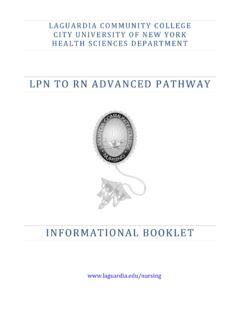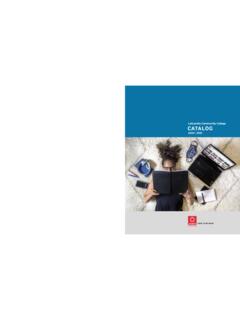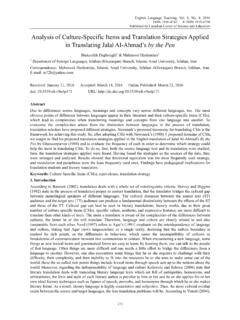Transcription of Unit 2: Greeting and Welcoming Guests
1 Project Hotel Curriculum 34 Center for Immigrant Education and Training (ACE) LaGuardia Community College Unit 2: Greeting and Welcoming Guests Project Hotel Curriculum 35 Center for Immigrant Education and Training (ACE) LaGuardia Community College Hotel TEACH Lesson Plan Unit 2, Lesson 1 Career Counseling: Confidence Building and Self-Presentation Objective: Sts will assess themselves to identify where they lack confidence, and practice various forms of self-presentation to present themselves confidently on the job.
2 EFF Standards Reflect and Evaluate: Make inferences, predictions or judgments based on one s reflections. Industry Standards Act with Professionalism & Integrity Communicate with Others Activity 1: Definition of Confidence T writes the following questions on the board and asks Sts to take 5 minutes and think about how they would respond. Sts can write notes if they need to. Where do you want to be in 5 years? What are your professional and personal goals? After Sts have taken the time to think of their answers, T breaks Sts into groups of 4 or 5 and asks them to get up in front of the class as a group and introduce themselves to each other and explain their goals and where they would like to be in 5 years.
3 After Sts in the groups introduce themselves, T asks the Sts: Who felt they could have used more confidence while making their introductions? Did anyone feel shy or uncomfortable? Would it have made a difference in their confidence if they had answered the question in their native language? Repeat with the next group of Sts. T asks Sts to describe confidence. T can use the following prompts to elicit responses: Confidence is believing in yourself and your ability to do a job well. Confidence is accepting yourself as you are and loving yourself unconditionally. Confidence is releasing fear of failure and trusting your ability to succeed.
4 Confidence is not being arrogant or conceited; confidence is being self-assured. Confidence is being relaxed. Confidence is a learned behavior. Project Hotel Curriculum 36 Center for Immigrant Education and Training (ACE) LaGuardia Community College T asks Sts to write the definition in their notebooks and/or journal. T then introduces the following stress-buster exercise. This exercise helps to reduce anxiety and feelings of nervousness and promote relaxation. 1. Sit or stand in a relaxed position. 2. Slowly inhale through your nose, silently counting to 5.
5 3. Let the air out from your mouth, silently counting to 8 as it leaves your lungs. Repeat several times. Activity 2: Assessing Self-Confidence T asks Sts to call out areas in their life where they feel confident, and lists them on the board in a column ( , as a parent, as a student, as a cook, their ability to be creative or communicate with others). Why do you feel confident as a _____? Why do you feel confident when you _____? T writes St responses on the board in a separate column. (Sample answers: I have experience in this role, practice, I have support, I get a positive response, I feel good doing this, I have studied this skill, etc.)
6 T explains that true confidence comes with time, experience, self-acceptance and positive self-esteem. If Sts can say why it is they feel unconfident, they can seek solutions to change the situation. T then asks Sts the following question and lists the responses on the board: What are some of the reasons why people feel unconfident? (Examples: They are new to a job and may not feel confident in their performance, low self-esteem, lack of support) T then asks Sts: Can you learn how to be confident? How? What can you do to change negative feelings and build confidence? (Examples: Be patient with yourself, look for support, talk to someone about insecurities, practice positive thinking, learn more about your new position, be motivated, be flexible, take inventory of all the positive things in your life, identify and use your strengths) Remind Sts that they can cultivate confidence, even if they don t always feel that way, by practicing relaxation techniques and positive thinking.
7 Activity 3: Confidence and Self-Presentation T asks Sts: Project Hotel Curriculum 37 Center for Immigrant Education and Training (ACE) LaGuardia Community College Why would employers look to hire people with confidence? Would they hire someone who is unconfident? Why or why not? (Example: Having confidence causes customers and co-workers to feel that you are reliable and competent. (A worker who displays unconfident behaviors may be viewed as less effective and unreliable.) T then distributes the following answer cards to Sts: OK in the United States.)
8 Not OK in the United States. OK in my country. Not OK in my country. T then reads aloud the following questions about confidence and instructs Sts to raise the cards that best reflect their opinion. Each St should hold up an answer that reflects whether it is OK or not OK in both his/her home country and the United States. Ask Sts to explain why they are holding up the answers they chose and give examples. While each statement is being made, T can act out what is being read. Is it OK or not OK to: Look at customers directly in their eyes when they speak to you. Look at the floor when your manager talks to you. Cover your mouth and look down when you are speaking.
9 Touch people on the shoulder when you explain something to them. Speak quietly when addressing a guest. Engage in small talk with customers and supervisors. Shake hands when you are introduced to a supervisor. Cross your arms when you are talking with Guests . Make jokes with your co-workers and supervisors. Ask your supervisor questions. After this exercise, T asks Sts to describe what confidence looks like in the United States. T writes down the answers on the board under the heading Confidence. T can elicit responses with the following questions: What is the body language? How is eye contact important? How do you stand when confident?
10 How is your head held? How do you feel? What do you do with your arms? Are they crossed? Are your hands in your pockets? At your sides? What message does this convey? How does confidence/nervousness affect your breathing? How is your physical distance from the person you are speaking with? Is it too close or too far? What kind of thoughts would a confident person be thinking? Project Hotel Curriculum 38 Center for Immigrant Education and Training (ACE) LaGuardia Community College Conversely, ask Sts, How does someone who is unconfident appear?











